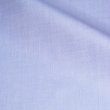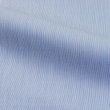Fabrics
Cotton
Cotton is a plant belonging to the Malvaceae family. Cotton is cultivated in various parts of the world such as Egypt, Sea Islands, South and North America, India.
Cotton fibers are obtained from the bolls of cotton plants, which contain 2-6 seeds. The fibers are attached to the seeds. The fiber most often is spun into yarn or thread and used to make a soft, breathable textile, which is the most widely used natural-fiber cloth in clothing today. Woven material is subjected to various processes to achieve optimal appearance and suppleness.
Materials can be woven using a single thread - one-ply or 2 threads twisted around each other - two-ply or TWO FOLD or Doppio Ritorto. This way you obtain a material that is more durable and great looking.
Thread count is simply how many threads of cotton are woven lengthwise and widthwise into an inch of fabric. 60's 80's 100's 120's 140's 170's is the number of threads per square inch and a method of measuring the quality of the material. The fabric is finer and more resistant as the number is higher. For example 120/2 - 120/2 - 2-PLY is a fabric with the warp yarns are 120 double per inch and the weft are 120 threads per inch double (1 thread double = 2 twisted around each other).
One of the most popular types of cotton is Egyptian cotton, known worldwide for its quality. Egyptian cotton is a luxurious cotton grown along the Nile with long cotton fibers. Some of its qualities are:
- An elegant shine when exposed to sunlight
- Excellent cooling in hot and humid days (you will sweat less and your shirt will feel cool)
- Durable
- Remarkable finesse
- A very pleasant feeling to the touch (soft)
Type
Poplin |
End on End Poplin |
Twill |
Herringbone |
Oxford |
Royal Oxford |
Pinpoint
|
Poplin - Poplin is a fine cotton woven from long staple yarn to produce a smooth, lightweight, silky fabric that is cool and comfortable to wear. It is strong and durable, resistant to shrinkage and weave stretching and can take strong and vibrant colour dyes.
End on End Poplin - End on end has the same properties as poplin, the only difference is that end on end features lighter coloured weft threads running in a horizontal direction on the shirt, giving it a subtle two-tone effect.
Twill - Twill is a cotton where the weft threads pass over one and then under two threads to produce a diagonal rib which catches the light giving an attractive sheen to the fabric. Very soft and easy to iron.
Herringbone - Herringbone twill has the same construction as a twill but the direction of the twill is alternated to give a zig-zag effect. It has a silky finish and smooth to the touch and feel.
Oxford - Oxford is a more rugged fabric woven from a heavier yarn than used in poplin. The threads in the warp (the vertical threads in the weave) are yarn dyed and are not as thick as those in the weft (horizontal threads), which are left a natural shade of white. The result is a heavier yet soft fabric. Oxfords are more durable weave and slightly heavier the Twills and Poplin fabrics.
Royal Oxford - Royal Oxford is a very fine yarn is used resulting in a fabric which is beautifully silky, much softer and smoother than classic Oxford. The Royal Oxford basket weave is more vibrant and deeper in color. It is the softest of the Oxfords in touch and feel.
Pinpoint - The Classic Pinpoint Oxford is the most durable. It has a flat finished weave. Maintenance is a minimum, because it does not wrinkle as much compared to other cotton weaves.
World renowned manufacturers of cotton fabrics: Tessitura Monti Italy, Cotonificio Albini / Thomas Mason, Alumo Switzerland.
Wool is the textile fiber obtained from sheep and certain other animals, including cashmere from goats, mohair from goats and angora from rabbits.
The quality of wool is determined by several factors: fiber diameter, crimp, yield, colour, and staple strength. Fiber diameter is the single most important wool characteristic determining quality and price.
One of the most popular and widely used types of wool is merino wool: very fine and high quality. The finest and most valuable wool comes from Merino hoggets. The main producers of Merino wool are in Australia and New Zealand.
Among the world-renowned manufacturers of wool fabrics are Ermenegildo Zegna, Marzotto (Marzotto, Guabello, Marlane), Lanificio di Marzoni, Loro Piana, Vitale Barberis Canonico.
Wool suits are the most popular suits on the market. There are different types of wool. For example, men's suits are made from virgin wool or worsted wool, that can be spun at different speeds to produce different levels of comfort.
Virgin wool is wool spun for the first time. composed exclusively of a fiber that was not previously incorporated into a finished product that has not been subjected to other processes of spinning and / or rolls than those needed for manufacturing product and not deteriorated during the treatment and processing. It is most fine quality wool produced.
Worsted wool is a resistant wool, grain long hair, with a hard surface. Worsted wool is the ideal fabric for a first suit. Durable and hard wearing, can be worn year-round. Depending on the weave, can be used for lighter and heavier suit.
90's 100's 110's 120's 150's 200's - is a method to measure the quality of the material. The higher the number the softer and more special the material is. Always remember that the quality of fabric dictates the price of a suit. A suit made of "60-80 twists" fabrics will obviously be cheaper than one made of 100 or super 110s for example. A "high-twist" 100 or super 110 means a suit is made of a worsted wool yarn that has been twisted more often than the usual 60-80 twist fabrics. Super 120 wool is one of the most expensive materials commonly used.
The advantages of a wool suit consist of durability, resistance to crease. Versatility leads to its use for both winter and summer, with the ability to keep warm in winter and cool in summer.
Silk , the most beautiful of all textile fibers, is acclaimed as the queen of textiles. It comes from the cocoon of the silk worm and requires a great deal of handling and processing, which makes it one of the most expensive fibers also. Country of origin is China, where silk was known 5000 years ago. Today China is the leading silk producer of the world. Other major silk producing countries include Japan, India and Italy.
Silk fiber is one of the finest natural fibers, has a pronounced sheen and is very elastic and resistant. Silk has a smooth texture and is soft, not slippery, unlike many synthetic materials.
Silk is one of the strongest natural fibers, in terms of tensile strength. Silk is very comfortable in hot weather and warm in winter, keeping warm air near the body due to its low conductivity.
Jacquard Silk is a woven silk, manufactured by using a process invented by Joseph Marie Charles, called Jacquard in 1801. Jacquard (b. July 7, 1752, Lyon - d. August 7, 1834, Oullins) was a French inventor, who invented the first semi-automatic loom. Jacquard silk colours and motives are obtained by weaving silk, creating great textures and complicated patterns.
Leather is a durable and flexible material created via the tanning of putrescible animal rawhide and skin, primarily cattlehide.
The skin is tanned using various substances and is sold in many forms.
Full-grain leather refers to the leather which has not had the upper "top grain" and "split" layers separated. The upper section of a hide that previously contained the epidermis and hair, but were removed from the hide/skin. Full-grain refers to hides that have not been sanded, buffed, or snuffed (as opposed to top-grain or corrected leather) to remove imperfections (or natural marks) on the surface of the hide. The grain remains allowing the fiber strength and durability. The grain also has breathability, resulting in less moisture from prolonged contact. Rather than wearing out, it will develop a patina over time.
Top-grain leather is the second-highest quality. It's had the "split" layer separated away, making it thinner and more pliable than full grain. Its surface has been sanded and a finish coat added to the surface which results in a colder, plastic feel with less breathability, and will not develop a natural patina. It is typically less expensive and has greater resistance to stains than full-grain leather, so long as the finish remains unbroken.
Natural fibers in the skin damage over time. Long exposure to low relative humidity (below 40%) can reduce skin quality, irreversibly changing the fiber structure.




